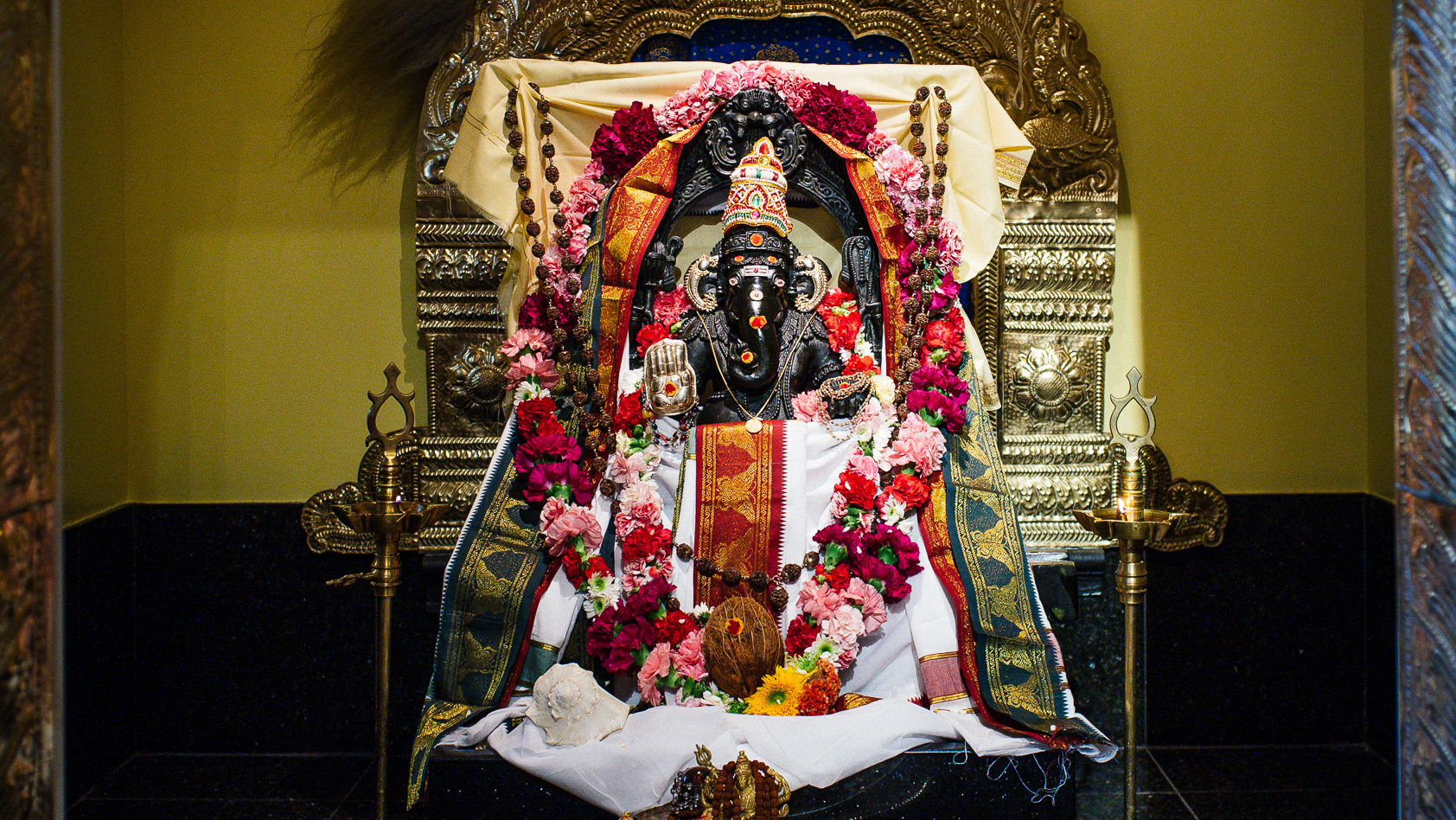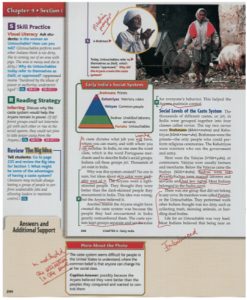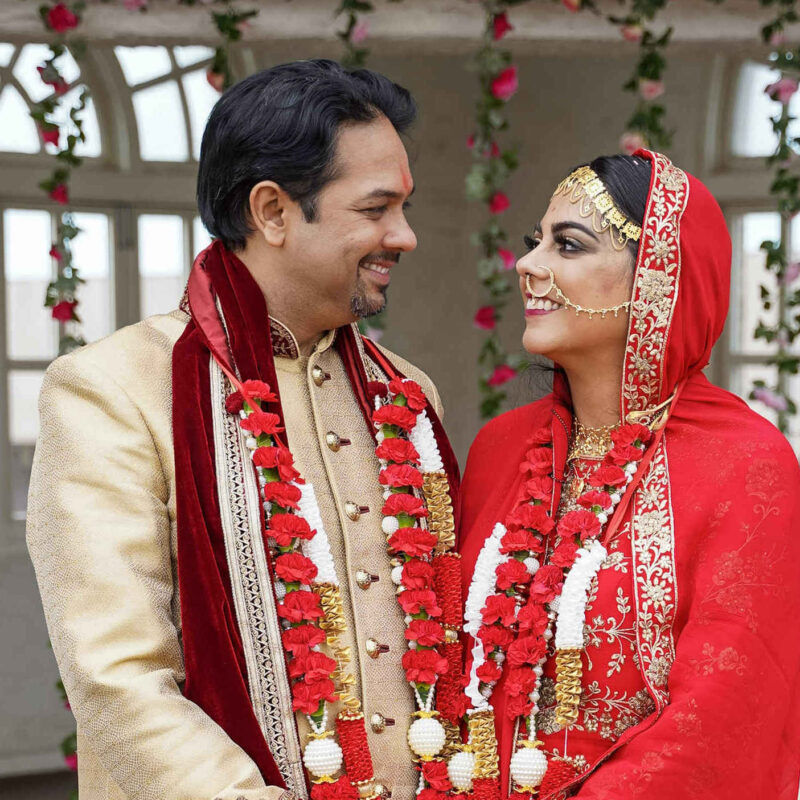
The karmakānda of the Vedas includes instructions of rituals. Such rituals are meant to be acts of worship and devotion to the one Reality in its various manifestations. Some rituals are to be undertaken for specific results. Hindu rituals, from the elaborate to the very simple, are conducted both at home and at temples.
Rituals include homa or havan, yajna, and pujā, all of which draw together all the five senses thereby centering the attention of the devotee performing the ritual and calming the devotee’s heart and mind through adoring focus of the chosen deity (deities) being invoked and worshiped in the ritual.
In these ritual forms of worship, a murti (deity; literally, manifestation which is three-dimensional) or two-dimensional image (ie. a photo or bimba or flat engraving) serves as an embodiment of the Divine, invoking the idea of that form and its attributes in the mind of the devotee. They are focal points designed to be aides in meditation and prayer. Hindus do not consider God to be limited to the murti, but it is a sacred symbol that offers a medium for worship. The murti or image thus serves as a powerful tool for contemplating the nature of the Divine.
Murti are also considered to house the power or energy of the Divine, which is infused as life-breath into the murti during a ceremony called prana prathishtā, and withdrawn at the end of ceremonious worship, when the murti is immersed in water during what is called a visarjan. Visarjan is also done without water when the Deity is released from the form that it was invoked in, so is a generic term used to conclude a puja for deities that do not have a permanent pratishta. It is this Divine cosmic principle which is worshipped in rituals like puja in one’s favorite form/s (Ishta Deva/ Ishta Devata) of the devotee.
In Hindu practice, puja is considered to be a technique or discipline for fostering the spiritual growth of a devotee by facilitating action (karma), devotion (bhakti), knowledge (jnāna), and focus and introspection (rāja or dhyāna), all of which is offered with humble and loving surrender to the Divine.
Puja literally translates to adoration or worship. It is considered to be an especially powerful form of worshipping the Divine because it combines physical, verbal, mental, and vibrational aspects of worship.
In any puja, the devotee treats their Ishta Deva as a revered guest in their home and heart, welcoming them with hospitality, serving them with love, and finally sending them off courteously back to their abode, seeking their blessings throughout the process.
The traditional 16-step puja is called the Shodashopachara Puja in Sanskrit — shodasha meaning 16, and upachāra meaning offering given with devotion. It can be performed for an Ishta Deva in a fairly short time period on a daily basis as a spiritual practice (sādhana) fostering discipline and devotion. This allows the devotee to set aside a given amount of time each day to remember and cultivate a personal connection to their favorite form of the Divine. Objects and actions offered in puja to the Divine act as vessels of the devotee’s faith and spiritual energy, which allow direct communication and interaction with the Divine. Over a lifetime, setting aside this time for worship every day helps the devotee to work toward remembering the Divine at all times and eventually to see the Divine in all things and beings around them.
The 16 step puja can also be performed over a longer period, sometimes hours together, for special occasions, festivals, and major events in life, such as rites of passage. In this case, the same 16 steps are expanded or added to, and each step is more elaborately attended to by the devotee, often through the guidance of a priest. Each step is given more time so that more material offerings and forms of worship, like chanting of hymns or other acts of devotion, can be offered at the feet of the Divine.
Specific instructions for these pujas are given in the karmakānda of the Vedas, as well as in various Smrti texts. Each of the 18 Puranas, for example, detail the specific preferences of the deity which they praise, and how that deity should ideally be worshipped. The Devi Bhāgavatam lists the specific colors, flowers, and food which Devi or the Mother Goddess loves, and these can be offered to Her in Devi puja. And Shiva Manasa Pujā, a hymn composed by a 9th-century realized master, enumerates some favorite items of Lord Shiva, which are illustriously imagined and offered at his feet in devotion.
The 16 steps common to most puja, along with the preparatory steps are outlined below. There is, of course, diversity in practice and the way in which different steps might be sequenced or grouped depending on sampradaya and deity tradition, as well as regional, community, and family tradition. Devotees may also perform puja with far fewer than 16 steps, with a daily practice as as simple as lighting a lamp and offering quiet shloka and mantra (prayers), or chanting one of God’s names using a japa mala or prayer beads (usually made with 108 beads).
The Bhagavad Gita Chapter 9.26 offers a beautiful description of a simple puja in which Lord Krishna says that even a leaf, flower, fruit or water if offered with unconditional love and devotion is sufficient and pleasing to God.
Preparation for Puja
The correct pronunciation and intonation for the mantras listed below can easily be found on YouTube.
Altar set-up
The altar of worship which houses the murti or image of the Ishta Deva are kept neat and clean. Decorations can be added according to the taste of the individual devotee and/or deity. Rangoli/kolam designs made with rice flour, grains, legumes, or flowers can also be made.
Āchamaniyam (Purification)
The devotee, having already bathed, takes three sips of water by placing a spoonful of water with their left hand in the base of the palm of their right hand and chants the following mantra to invoke their own purity of body, mind, and spirit.
Oṃ Acyutāya Namaḥ
Oṃ Anantāya Namaḥ
Oṃ Govindāya Namaḥ
Salutation to the Lord who is imperishable
Salutations to the Lord who is without limits
Salutations to Lord Govinda
Deepa jyoti
Clay or metal lamps with clarified butter (ghee) or oil and wick are symbolic of the victory of knowledge over ignorance. The devotee lights the wick, places palms together at the heart center, and chants:
shubham karoti kalyānām ārogyam dhana sampadah |
shatru buddhi vināshāya deepa jyoti namostute ||
My respect to the light that brings auspiciousness, good health, prosperity and abundance |
that which destroys the darkness of ignorance with the light of knowledge. I bow to you ||
Vighneshwara Dhyānam (Contemplation on Ganesh, the Remover of Obstacles)
The devotee undertakes specific hand gestures chants mantra dedicated to Lord Ganesha asking that any obstacles be removed during the pujā. Two such mantra are:
ganānantva ganapati gum havā mahe
priyānantva priyapati gum havā mahe
nidhinantva nidhipati gum havā mahe
vāso mamha āham jā nigarvādhamvā tvamajā sigarvādhamvā
We honor and invoke You with offerings, Lord Ganapati, Keeper of the Paths
We invoke You with love and affection, Lord Ganapati, Creator of Life
We invoke You with offerings of treasures, Lord Ganapati, Protector of Wealth
Resonate within me, and bring forth within me the realm of the Divine
shukla ambara dharam vishnum shashi varanam chatur bhujam |
prasana vadanam dhyāyet sarva vighnopashāntaye ||
We meditate on the One in white attire, who is all pervading, bright as the moon, and four-armed |
Salutations Compassionate One with a kind face, we pray to the Lord Who Removes all Obstacles ||
Prānāyama (Breath Control)
The devotee undertakes specific actions to align the vital airs.
While closing the right nostril with the right thumb, inhale through the left nostril and the devotee mentally chants:
om bhuh om bhuvah om suvah om mahah om janah om tapah om satyam
Invocations to the physical plane, the plane of life-breath, the plane of the Divine mind, the plane of all-pervading Consciousness, the plane of all-creating Consciousness, the plane of Divine light, the plane of Truth-Consciousness
Holding the breath inside by closing the right nostril with the right thumb and left nostril with right ring finger, the devotee mentally chants:
om tatsaviturvarenyam bhargo devasya dhimahi dhiyo yo nah pracodayāt
May the light of consciousness come to shine forth its radiance through our intellects
Closing the left nostril with the right ring finger and exhale through the right nostril and the devotee chants mentally:
om āpo jyotiraso mrtam brahma bhurbhuvasuvarom
Salutations to the Divine Consciousness Who is all-pervading, ever bright, of divine essence, immortal, bliss-filled nectar, Truth-Consciousness-Bliss
Sankalpa (Intention; literally, good thought)
The devotee establishes intention or purpose of pujā. The specific blessings requested of the Divine are stated here. The devotee turns the left palm upward and places it on the right thigh. They then turn the right palm downward, and place it on top of the left palm and chant:
mamo patta samasta durita kshaya dvara |
sri parameshvara prityartham devapujam karishye ||
To remove all negative thoughts, words, and actions that I have accrued over lifetimes |
To be worthy of the Divine’s grace, I begin this worship ||
Āsana Pujā (Worship of the seating on which puja is performed)
The devotee invokes Mother Earth, as she is ultimately the Being on which people live and sit).
om prthvi tvayā dhrtā lokā devi tvam vishnunā dhrtā |
tvam ca dhāraya mām devi pavitram kuru ca-āsanam ||
O Mother Earth, Upholder of the Worlds. Vishnu holds you |
May you hold me, O Mother Earth, and purify my seat ||
Ghanta Pujā (Worship of the Bell)
The devotee uses a bell to invite the Divine and dispel negative forces during the pujā is invoked.
āgama-artham tu devānām gamana artham tu rakshasām |
ghanttā-ravam karomya āadau devatā āhvāna lānchanam ||
For the arrival of the good forces and departure of destructive forces |
I ring the bell, marking the invocation of auspiciousness that comes with the Divine manifestations ||
Kalasha Pujā (Worship of the pot/vessel)
The Goddesses of the sacred rivers are invoked and invited by the devotee into the water in the panchapātra (vessel made with five materials) which will be offered during pujā.
gange cha yamune chaiva godāvari sarasvati |
narmade sindhu kāveri jalesmin sannidhim kuru ||
The sacred rivers Ganga, Yamuna, Godavari, Sarasvati, Narmada, Sindhu, Kaveri
May your holiness be present in this water
Ātmā Pujā (Worship of the Divinity in the self)
The Divine self present in the devotee is invoked by the devotee.
deho devalayah proktah jivo devassanātanah |
tyajedajannanirmalayam so’ham bhāvena pujavet ||
The body is the temple. The jiva is the eternal deity of this temple.
May I remove the wilted flowers that symbolize ignorance and
Worship the Divine knowing the Divine is not separate from me.
Guru Dhyānam (Contemplation on Guru)
The Guru, by whose grace the puja can take
place, is invoked by the devotee.
gurubrahma gururvishnuh gururdevo mahesvarah
gurusāksat param brahma tasmai srigurave namah
The Guru is Brahma, the Guru is Vishnu, the Guru is Mahesvara |
The Guru is Ultimate Reality, My obeisances to the Guru ||
Shodashopachara Puja
There are five steps within the 16 which are central to the shodashopāchara pujā. They are referred to as the pancha upachara and correlate to the five senses: touch, hearing, smell, sight, and taste. The pancha upachara are gandham, pushpam, dhoopam, deepam, and naivedyam. Gandham involves touch in applying various pastes and powders to the murti. Pushpam involves sound as the deity’s name is chanted with each offering of flowers. Dhoopam involves sound as incense is offered. Deepam involves sight in the offering of light. And naivedyam involves taste from the food offerings made to and blessed by the Divine.
Dhyānam & Āvāhanam
The Divine is invited into the devotee’s home and heart with a meditation.
Chant: om sri [Deity name] āvāhanam samarpayāmi
Āsanam
A seat is offered by the devotee to the Divine form.
Chant: om sri [Deity name] āsanam samarpayāmi
Pādyam, Ārghyam & Āchamanyam
Water is offered by the devotee who washes the feet and hands of the Divine form. Water is also offered to the Divine to wash their face and mouth, just as one might traditionally offer a guest who has come into the home after journey.
Chant: om sri [Deity name] pādyam ārghyam āchamaniyam samarpayāmi
Madhuparkam
Honey, sugar, ghee (clarified butter), curd (yogurt), or water is offered by the devotee to the Divine form for refreshment.
Chant: om sri [Deity name] madhuparkam samarpayāmi
Snānam
Water is offered by the devotee to bathe the Divine form. In longer pujas, the five items included in panchāmrit (honey, sugar, milk, curd, and ghee) are used in bathing the Divine form as well. Sacred hymns are chanted during this process.
Chant: om sri [Deity name] snānam samarpayāmi
Vastram
Clothing is offered by the devotee to the Divine form after bath.
Chant: om sri [Deity name] vastram samarpayāmi
Yagnoveetam
Sacred thread is offered by the devotee to the Divine form after bath.
Chant: om sri [Deity name] yagnopaveetam samarpayāmi
Ābhāranam
Divine form is bedecked with ornaments by the devotee. Songs are sung in praise of the Divine form during this process.
Chant: om sri [Deity name] ābhāranam samarpayāmi
Gandham
Sandalwood paste, kumkum or vermillion, and haldi (turmeric) or vibhooti (sacred ash), are offered by the devotee.
Chant: om sri [Deity name] chandanam samarpayāmi, om sri [Deity name] sindoor tilakam samarpayāmi, om sri [Deity name] haldiyam samarpayāmi, om sri [Deity name] vibhooti samarpayāmi
Pushpam
Flowers are offered by the devotee to decorate the Divine form. In longer pujas, 108 or 1008 flowers are offered, one for each name of the Divine form, chanted in ashtottara nāmāvalis or sahasranāmas. In shorter pujas, just a few well-known or favorite names of the Divine form are chanted with each flower being offered.
Chant: om sri [Deity name] pushpam samarpayāmi
Dhoopam
Incense is offered by the devotee to please the Divine form.
Chant: om sri [Deity name] dhoopam samarpayāmi
Deepam
Another lamp is lit and offered by the devotee to the Divine form.
Chant: om sri [Deity name] deepam samarpayāmi
Naivedyam
Fresh food is offered by the devotee to the Divine form. Water is also offered again to cleanse the mouth of the Divine after naivedya has been consumed.
Chant: om sri [Deity name] naivedyam samarpayāmi
Tambulam
Betel nut and leaves, which have symbolic meaning, are offered as mouth fresheners after the meal. Coins or larger monetary amounts are also given as offering.
Chant: om sri [Deity name] tambulam samarpayāmi
Karpoora Niranjanam
ārati for the Divine form is shown and offered by the devotee.
Chant: om sri [Deity name] karpoora samarpayāmi
Pradakshina & Namaskāram
The Divine form is circumambulated, or the devotee stands in place and turns around three times clockwise, symbolizing that the devotee worships the Divine as the center of their life, around which their life revolves. The devotee bows down to the Divine, and asks for forgiveness of any mistakes committed during the puja process and sends off the Divine form with gratitude.
Chant: om sri [Deity name] pradakshina samarpayāmi; om sri [Deity name] namaskāram samarpayāmi
Pradakshina & Namaskāram
The Divine form is circumambulated, or the devotee stands in place and turns around three times clockwise, symbolizing that the devotee worships the Divine as the center of their life, around which their life revolves. The devotee bows down to the Divine, and asks for forgiveness of any mistakes committed during the puja process and sends off the Divine form with gratitude.
Chant: om sri [Deity name] pradakshina samarpayāmi; om sri [Deity name] namaskāram samarpayāmi
Conclusion
The devotee chants the following closing mantra.
kāyena vācā manase indriyairvā buddhy ātmanā vā prakrteh svabhāvāt |
karomi yad yat sakalam parasmai nārāyanāyeti samarpayāmi ||
Whatever I do with my Body, Speech, Mind, or Senses, Whatever I do using my Intellect, Feelings or unconsciously through my natural tendencies |
Whatever I do, I do selflessly for others and surrender them all at the Lotus Feet of the Divine ||









































